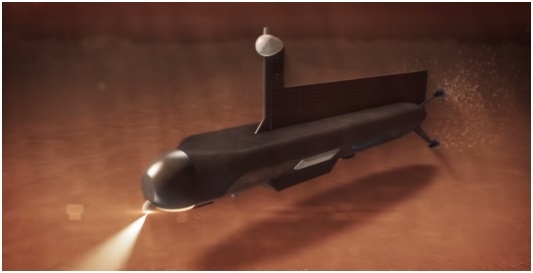Titan is the largest moon of Saturn. It is also the only natural satellite of a planet in our solar system that has a dense atmosphere. It is also the only natural satellite where large stable bodies of liquid have been found on the surface. Titan is the second largest moon in the solar system. It is larger than the planet Mercury and fifty percent larger than the Earth's Moon. Titan is primarily composed of water ice and rocky material. The atmosphere is largely nitrogen. The atmosphere is one and a half times as dense as the atmosphere of the Earth although the gravity is only fourteen percent of Earth's gravity. The temperature is around two hundred and ninety degrees below zero on the Fahrenheit scale. Voyager and Cassini probes flew by Titan and the Huygens probe landed on the planet in 2004.
There are three hydrocarbon polar seas on Titan with a composition similar to liquid natural gas. The largest, Kraken Mare, covers over one hundred and fifty thousand square miles. The estimates of the maximum depth of Kraken Mare vary between five hundred and one thousand feet. Saturn causes tides which result in complex shorelines with deposits of evaporated material.
NASA recently held the 2015 NASA Institute for Advanced Concepts Symposium at Cocoa Beach, Florida. At the Symposium, NASA engineers presented a report on the Titan Submarine Phase I concept design. The report discusses a possible mission to Titan where the robot submarine would explore the polar seas of liquid hydrocarbons. The Titan sub would weigh a ton and use electrical propulsion for a ninety day mission covering over twelve hundred miles. The sub would have to be delivered to the surface of Titan by a lifting body that could survive atmospheric entry. The sub would be able to travel at about two miles per hour.
Sending an orbiter with the sub to relay information to Earth would be cost prohibitive. Instead, the sub has a large dorsal fin with a planar phased-array antenna to send information to Earth. It would surface for sixteen hours a day to send data. Because of uncertainty about the density variations in the hydrocarbon liquid, the ballast tank system is still under development. Problems with atmospheric density and temperature means that instead of using air pressure to manage the ballast tanks, some sort of piston system will have to be built to force liquid in and out of the tank.
NASA has not presented details about the purpose of the Titan sub mission but it will probably include a full set of research goals. The sub will probably study the structure and composition of the liquid hydrocarbons. Sediment from the bottom of the sea will probably be a target. Since Titan has so many organic chemicals, the sub might look for possible precursors to life on Earth.
Artist's concept of Titan submarine:
